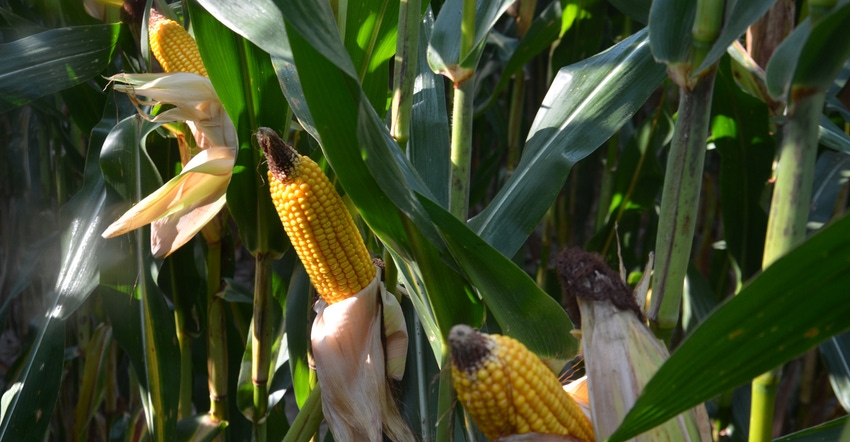
One impact of dry weather stress or outright drought in corn will likely be smaller kernel size than the same hybrid could have achieved under better conditions. Expect kernels to be lighter in fields where plants shut down early, says Bob Nielsen, Purdue University Extension corn specialist.
“One of the early signs we noticed in drier areas was droopy ears during the latter part of grain fill,” he says. “The unusually early change from upright ears to ears hanging down suggested a loss of turgidity in the ear shank due to stress.
“It could be combined with cannibalization of carbohydrates in the ear shank similar to what can occur with the stored reserves of the main stalk in response to severe photosynthetic stress. Eventually, the ear shank collapses and the ear droops down.”
Yield impact
The real question is how much early shutdown and premature formation of the black layer in kernels impacts yield. The impact can be significant, Nielsen notes, yet maybe not as catastrophic as you’d expect. It certainly shouldn’t be as dramatic as what some growers saw in 2012, when drought and extreme heat developed early in the growing season.
The timing of when ear shanks collapse and ears droop determines the magnitude of the expected yield loss, Nielsen says. If grain fill was totally shut down at full dent stage, with the milk line barely visible at the dent of kernels, yield loss would be as much as 40%.
If grain fill was totally shut down at late dent stage, with the milk line halfway between dent and the tip of kernels, yield loss for affected ears would equal about 12%.
The rub comes in when determining how many ears were affected. Multiplying percentage of affected ears by estimated yield loss per ear will give you an estimate of whole field loss, Nielsen explains.
For example, if 10% of the field contains plants with ears that drooped prematurely at the late dent stage, whole field loss would be estimated at 1.2%. That’s 10% of the ears multiplied by 12% yield loss per ear. If yield potential was 200 bushels per acre, that’s only about a 2.5-bushel-per-acre loss for that one factor.
Other factors
Even if ears didn’t droop, if dry weather slowed the flow of starch and resulted in smaller kernels, yield will drop off. The yield estimate formula is very sensitive to the number used to represent kernel weight in the equation, Nielsen says. If you use 85 as the factor in a normal year, and this year 90 or even 95 is more realistic due to smaller kernel size, yield estimates will fall considerably.
Nielsen also observed aborted kernels on more ear tips than usual in some drought-stressed fields. However, aborted kernels and bare cob tips were also reported in areas with adequate rain until corn reached black layer.
“There was a long string of very cloudy days in some of those areas during grain fill,” Nielsen says. “It’s possible that less light than normal caused insufficient photosynthesis and led to kernel abortion.”
About the Author(s)
You May Also Like




